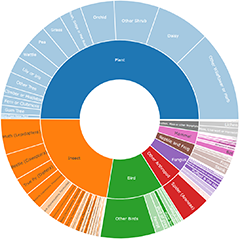Big Eucalypts of the South Coast
Posted by Steve818
Overview of the Big Eucalypts project
This is a collection of the largest recorded individuals of different Eucalypt tree species (Eucalyptus, Corymbia & Angophora) on the NSW South Coast. The collection complements exisitng big and giant Eucalypt collections on citizen science platforms in other parts of the country. For example, The National Register of Big Trees https://www.nationalregisterofbigtrees.com.au/pages/home-page and Dr Dean Nicolle's reference collection of giant Eucalypts in Tasmania, for example https://inaturalist.ala.org.au/observations/192037411 .
Why are big Eucalypts important? They support a diverse range of other species. Big Eucalypts often contain multiple tree hollows for hollow dependent fauna. More than 300 species of Australian native animals use tree hollows for shelter and breeding, including iconic birds such as black cockatoos. Big Eucalypts are major carbon stores both in wood volume and root biomass.
How big is ‘Big’?
The threshold trunk girth and/or height for a big Eucalypt varies with the species. So the best approach to decide whether you have found a big individual is to compare it to those of the same species in this collection, or in the national register of big trees: https://www.nationalregisterofbigtrees.com.au/pages/home-page
How to contribute
The collection relies on trunk circumference, i.e. trunk girth, because measurement of height requires specialised equipment (clinometer, laser range finder, or LiDAR).
Ensure that trunk girth is measured 1.4m above the ground to avoid the effect of the buttress on the measurement.
If height has been measured then record the height in the notes or comments along with the measurement method.
To add your big Eucalypt sighting to this project select the star icon at the top right of the sighting and select the Big Eucalypts of the NSW South Coast collection name.
Examples of big Eucalypts on the South Coast
- The Big Tree is a spotted gum at Narooma with an approx. trunk girth of 8.9m and 40.3m tall https://southcoast-nsw.naturemapr.org/sightings/4518953
- Old Blotchy is a spotted gum at Murramarang National Park with a trunk girth of 10.8 m and 59m tall https://southcoast-nsw.naturemapr.org/sightings/4575714
- A giant spotted gum called 'Big Spotty' in North Brooman State Forest with a trunk girth of 10.31m and 69.1m tall https://southcoast-nsw.naturemapr.org/sightings/4580420
Add a sighting
- Collection type Research project
Follow this collection
Receive alerts of new sightings
SubscribeFilter
- All sightings 14
- Significant sightings 0
- Unidentified sightings 0
- All sensitivity levels (change?)
- All conservation levels (change?)
- All invasiveness levels (change?)
Categories
- Plants
- Birds
- Mammals
- Reptiles and Frogs
- Insects
- Spiders (Araneae)
- Other Arthropods
- Other Invertebrates
- Fungi
- Lichens; Mosses & other Bryophytes
- Algae, Cyanobacteria, other bacteria and viruses
- Slime Moulds (Myxomycetes)
- Fossils & Geological Features
- Fish
- Marine Invertebrates
- Marine Algae & Seaweeds
Share to contribute
Share link to contribute to Big Eucalypts of the South Coast





























